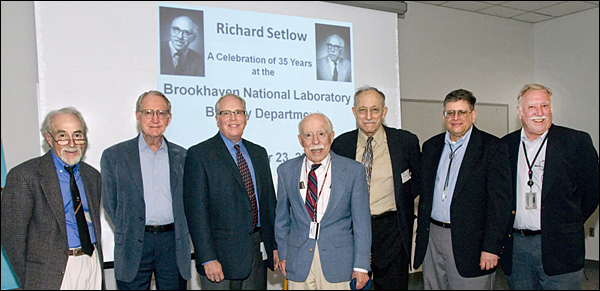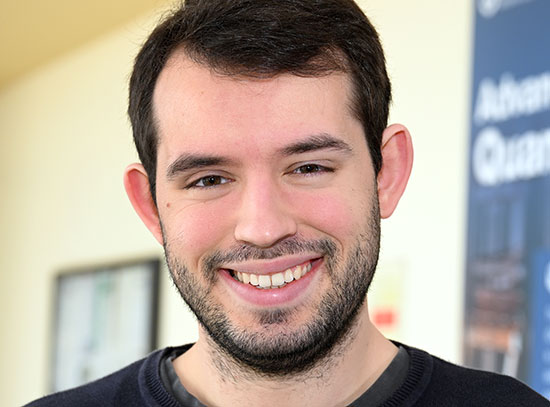Richard Setlow Honored at Celebration Symposium
October 7, 2009
Colleagues, friends and family honored Richard Setlow, Senior Biophysicist Emeritus, at a “celebration symposium” sponsored by the Biology Department on September 23, the date he received his 35th BNL Anniversary Award. The Biology Seminar Room was filled with laughter and applause, as invited speakers shared humorous stories and inspirational reminiscences of Setlow’s work and life.
 enlarge
enlarge
Speakers at the Biology Department’s Celebration Symposium joining the guest of honor, Richard Setlow (center), are (from left) Peter Setlow, Philip Hanawalt, Daniel Yarosh, Arthur Grollman, Kenneth Kraemer, and Carl Anderson, who gave the introductions. Speakers unavailable for the photo are Joanna Fowler, Nicholas Samios and Avril Woodhead.
Setlow joined BNL’s Biology Department in 1974 after working as a biology research staff member at Oak Ridge National Laboratory (ORNL) since 1961. In 1979, he was named chair of the Biology Department, and in 1986, he became the Associate Laboratory Director for Life Sciences, a position he held until he returned to full-time research in 1998. He retired in 1999, while still continuing to perform research until last year.
Setlow is known internationally for his research on DNA damage and repair. In the 1960s, Setlow and colleagues discovered that DNA defects caused by ultraviolet light lead to biological damage. He showed that cellular enzymes could repair these defects in normal bacterial cells. His groundbreaking research led to much interest in the topic, since some genetic diseases and cancer can result from deficiencies in DNA repair.
In the 1990s, Setlow and his colleagues found that all ultraviolet wavelengths of sunlight cause malignant melanoma, contrary to the popular belief that only short ultraviolet light wavelengths were potentially harmful. Soon after, sunscreens were formulated to protect against both UVA and UVB rays.
Early Years
After a brief introduction, in which Biology Chair Carl Anderson praised Setlow for his 35 years of distinguished research and administration at BNL, he introduced the speakers. First to speak was Philip Hanawalt, professor of biological sciences at Stanford University, who was one of Setlow’s first graduate students at Yale University in the 1950s. He noted that Setlow steered him in “his life-long career direction.” Setlow had received a bachelor’s degree from Swathmore in 1941 and a Ph.D. from Yale in 1947. He taught physics and biophysics at Yale before joining ORNL.
Daniel Yarosh, vice president of basic research at Estée Lauder™, was a postdoctoral fellow mentored by Setlow at BNL in 1979 to 1980. He spoke about Setlow’s calm attitude in the face of critics, and said he learned to have that confidence in his own work from Setlow.
A Wide Influence
Kenneth Kraemer, senior investigator and head of the DNA Repair Section at the National Institutes of Health, gave a brief history of DNA repair, showing video clips of Setlow speaking about his research on June 20, 2000.
Arthur Grollman, founding chair of the Pharmacology Department at Stony Brook University, quoted extensively from a graduate student who praised Setlow as a mentor. She said that Setlow taught her “how to think.” Grollman remarked that while Setlow is known for “great science,” he has done even “greater things” by passing on his knowledge and wisdom to the next generation.
BNL Memories
Nicholas Samios, BNL Distinguished Senior Scientist and director of the RIKEN BNL Research Center, was the Laboratory Director during much of the time that Setlow was Associate Laboratory Director for Life Sciences. Their careers intersected earlier also, when they were both department chairs. Samios recalled their interactions as administrators with fondness, praising Setlow as an exceptional “administrator, scientist and educator.” who could “lead, listen and gauge excellence.”
Joanna Fowler, a senior chemist in the Medical Department and director of BNL’s Radiotracer Chemistry, Instrumentation and Biological Imaging Program, said she admired Setlow because he has always been “very supportive of science and scientists” and “never compromised quality” in research. Also, he is a “kind, generous and good friend.”
Avril Woodhead, who worked with Setlow for 25 years before joining the Information Services Division as a senior writer/editor, recalled that being part of Setlow’s team was both fun and inspiring. She spoke of the many hot summers and cold winters spent in the Biology greenhouses tending to the fish that Setlow and his colleagues used for his experiments. One of their most important findings came about accidently. They forgot to cover the fish tanks exposed to UV light, and they discovered later that UVA wavelengths were important in melanoma development.
Thinking about the “mistake,” Woodhead remarked that one of Setlow’s rules was to “never blame anyone for a mistake.” Also, she recalled that despite a steady stream of visitors, Setlow always had time to help his students and postdoctoral fellows.
Setlow’s son, Peter Setlow, professor of molecular, microbial and structural biology at the University of Connecticut Health Center, had more personal reminiscences of his father, recalling that Setlow had many interests besides science. In fact, in his younger years, he was an excellent athlete, an actor in community theater, and a volunteer at a camp for physically disabled adults. He said he admired his father for the way he thought of unique solutions to problems, not just as a scientist, but also in daily life.
After the formal presentations, John Sutherland and Bill Studier, both of the Biology Department, spoke briefly to the audience about Setlow’s important influence on them. Studier remembered that Setlow was a “great teacher in the lecture courses” at the time he was an undergraduate at Yale.
Laboratory Director Sam Aronson presented Setlow with his 35-year anniversary certificate and gift, and Setlow thanked the audience for their kind words and laughter.
2009-1435 | INT/EXT | Newsroom









